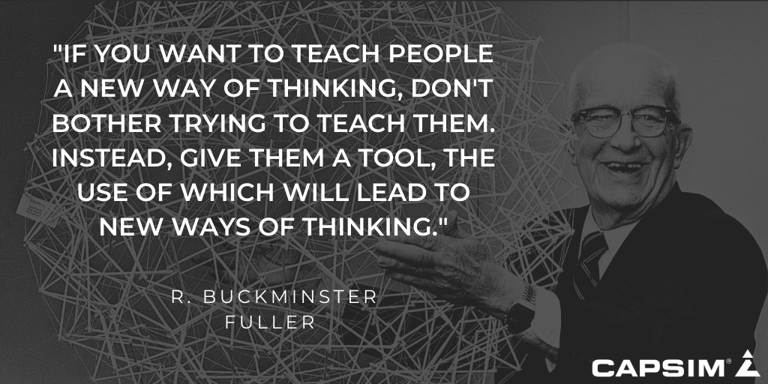A New Tool for Thought
July 24, 2020

By Brendan Langen, Director of Product Design & Development at Capsim
Let’s briefly talk about tools for thought. From a simple frame, the goal of an educator is to prepare students for the future. We want students to grasp the content, know how to apply it, and use their insights in a broader context. Typically, the tools you use in your (now virtual) classroom are books, videos, discussion boards, and simulations to name a few.
Any of these tools can change a learner’s life. A good book read at the right time has opened the eyes of many students. My entire worldview changed when reading Thinking, Fast and Slow by Daniel Kahneman. An open discussion in a classroom environment can lead to Eureka! moments that spread far beyond the course.
That’s not to say all tools are created equal, though.
The illustrious philosopher and inventor, Buckminster Fuller, was known for his views on education and tools, specifically. His quote below articulates what we all know — to truly change someone’s mind, we need the right tools to enable us.

The CapsimInbox Authoring Platform is said tool. The experience of diving into an email Inbox to solve problems is familiar and lifelike. It’s not only fun for students, but more effective.
Take the recent research done by Dr. Erich Dierdorff and Dr. Bob Rubin, publishers of multiple CapsimInbox microsimulations.
After creating versions of Inbox: General Management and People Management, they validated the performance of 398 students alongside supervisory ratings of their overall job performance.
The proof is here, in our Technical Synopsis:
CapsimInbox overall scores were positively correlated with supervisory ratings of overall job performance effectiveness (r = .43, p < .01). By way of comparison, a meta-analysis of assessment center studies found the average correlation between assessment center scores and job performance to be .37 (Gaugler et al 1987).11
CapsimInbox skill scores showed higher correlations with parallel performance dimension ratings by supervisors (average r = .30, p < .01) compared to non-parallel performance dimensions (r = .12, p < .05)
Overall, these results described above provide supportive evidence for the criterion-related validity of CapsimInbox.
Taken collectively, these results indicate that each assessed skill contributes to overall assessment performance in an adequately balanced manner across CapsimInbox versions.
In short, students who performed better in Inbox situations performed better at work. This is the exact outcome we hope for.
We know that learners best grasp a concept when they are an active part of it. We call this experiential learning, and the evidence repeatedly bears out its impact on the acquisition of knowledge. Yet, it’s never been easy for experts to create learning experiences that put the learner in a position of agency.
Reading text, watching a video, or even analyzing a case study keeps the student in the outsider’s perspective, reviewing something that someone else has done. What we ideally want to do is put them in the driver’s seat. With CapsimInbox, students experience that moment firsthand.
The path to building your Inbox may seem overwhelming. Where do I start? As a Product team, it’s our mission to make it as easy as possible for you to bring your expertise to life.
Thus, we are here to help you. If you have an idea that you want to bring to life, sign up to play around with the Inbox Authoring Platform. If you get stuck, we’ll be here to help you share your insights with the world.
In working with dozens of educators bringing their stories to life with CapsimInbox, the most common thing we hear is this:
“There weren’t tools that applied the concepts from the classroom to the real world.”
CapsimInbox Authoring Platform crafts learning experiences that better prepare your students for life beyond graduation. That’s all we’re trying to do.
We have built the tool, but the most important part is you. You have the expertise. Together, we can change the way our students think about the future. Join us here.


.png?width=80&name=1-questions%20(1).png)